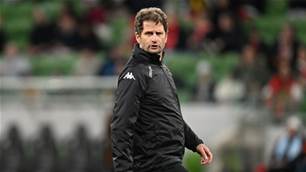You know women’s football is having a moment when your elevator conversation involves not making small talk about the weather but someone saying to you: ‘How about those Matildas? And that Sam Kerr!’
Side note: Both those statements warrant a greater response than is possible in an elevator ride and I apologise to the people kept waiting while we jammed open the doors to talk.
But as a long-suffering women’s sport supporter, what interests me is less that women’s football is having a well-deserved moment than how it is, and why now?
Everyone loves a winner(s)
The Matildas have long been Australia’s most successful football team—they won the Asian Cup and made it to World Cup Quarter Finals well before the Socceroos ever did. The Matildas have actually been on the cusp of greatness a number of times, but stumbled at the hurdles: They crashed and burned against a beatable Sweden in the 2011 Women’s World Cup Quarter Final. And they missed out on progressing to the final four at the 2016 Rio Olympics after going down to Brazil on penalties: 7–6.
But 2017 has proved the breakthrough, both mentally and in terms of results. The Matildas won the inaugural Tournament of Nations by outclassing footballing powerhouses USA and Brazil, following it up with two comprehensive victories over the South Americans in front of packed Penrith and Newcastle stadiums.
This success—and the infectious enthusiasm for supporting the team—has also been aided by players’ stellar individual National Women’s Soccer League (NWSL) performances, including that of Hayley Raso, who was a fan favourite and consistent starter in championship-winning team the Portland Thorns. Oh, and Sam Kerr, who’s always been a goal-scoring, back-flipping firecracker, and who is being recognised for her skill at every awards level—except, it seems, FIFA’s.
With the Matildas finally achieving some of the success for which they’ve long been poised, it’s unsurprising that female footballers are currently among Australia’s sporting darlings.
Other sports are raising the bar
With Cricket Australia and Netball Australia lifting their respective games in terms of player salaries, coverage, and support (e.g. offering maternity leave), and with the AFLW poaching players from other codes left and right, women’s football organisers have had their hands forced into stumping up some cash and better terms. (Nothing like the fear of losing talented players to other leagues to sort out priorities, eh?)
It comes too late for current Canberra United coach Heather Garriock, whose playing career ended due to the absence of maternity leave. But the $10,000 Season 10 base retainer for every W-League player, especially when combined with salaries from international duties and stints in decently paying overseas leagues, is helping to retain athletes who would otherwise be financially forced to leave. And, by enabling players to concentrate on training rather than part-time work, that retainer is improving the football quality.
Other leagues and hemispheres are providing playing continuity
Being able to play year-round (thank you northern hemisphere for having opposite seasons, sizeable salaries, and compatible football schedules) is providing players with top-tier game continuity, which has meant a smoother transition to, and higher overall standard for, international and domestic matches.
(Side note: One can hope, although it would require long-term research, that this playing continuity will result in fewer serious knee and other injuries as players experience steady strength, conditioning, and loading.)
This higher standard also means northern hemisphere players like Welsh player–coach Jess Fishlock and up-and-coming USA defender Emily Sonnett are being enticed south in their off-season, symbiotically bringing their skills and fan followings with them.
Broadcasts and other leagues are providing coverage continuity
We’re finally able to fairly consistently see women’s football.
Because for so long, if you couldn’t physically be at the game, you couldn’t see it. Or in the absence of replays, you couldn’t see it even if you were physically at the game but just happened to momentarily not be paying attention. That or if the action occurred on the other side of the pitch amid a crush of bodies.
We’re a way off broadcasting every single W-League match. But at two matches a week (plus Matildas’ games coverage), the broadcast coverage is double what it’s been previously. If we double it again next season, we’ll be at full capacity. Broadcasting more games also means we’re more likely to see matches that will determine the final four—in the past, the rigid broadcast schedule often meant dead rubbers were shown and crunch matches played out with little audience.
Dovetailing with this: the ease of following players in overseas leagues preceding and following the W-League season via apps, live streams, and other league-produced content has provided ongoing coverage and momentum during southern hemisphere off-season times. (Think seeing Sam Kerr’s golden boot-winning goals, Alanna Kennedy’s and Steph Catley’s stellar Orlando Pride defence, and Hayley Raso’s championship-winning final with the Portland Thorns.) These are times when players would otherwise disappear—some to overseas leagues rendered invisible to Australian audiences by restrictive broadcast rights; others to catch up on the earnings and learnings they missed while, due to poor or non-existent remuneration, essentially playing football for free.
Players are contributing to, and plugging, coverage gaps
While social media is a powerful tool for just about every athlete, it’s arguably most powerful for female athletes because it allows them some content and coverage control. That is, they are working alongside governing bodies and broadcasters rather than having to rely on those bodies and broadcasters to be benevolent or do a good job.
Australia’s female footballers are leveraging this potential, documenting their training, everyday and match-day lives, drip-feeding content to keep women’s football front of fans’ minds, sustaining and ramping up interest around seasons and key games. (Hayley Raso, Elise Kellond-Knight, and Laura Alleway have taken that a step further, penning articles for athlete-founded and -led Exclusive Insight.
So women’s football is all set from here, right?
Not quite.
Women’s sport generally, and women’s football specifically, is having a moment. But moments pass and momentum falters, and funders move money elsewhere if they fail to see a return on their investment (read: to sports such as cricket, which currently offers the greatest remuneration for Australian female sportswomen and which already features crossover athlete Ellyse Perry).
This season we can see women’s football in a variety of ways—in person, on pay TV, on free-to-air TV, on live streams, and via social media. Ways we’ve been asking for for years and that we need for holistic coverage. But ticket sales, social media stats, and broadcast viewerships don’t lie. We need to turn up and tune in to support women’s football while we can see it, and send a message that we want to see even more.
Related Articles

Matildas star Raso leaves Real Madrid for Tottenham

Kerr, fellow Matildas to be consulted in coach search













